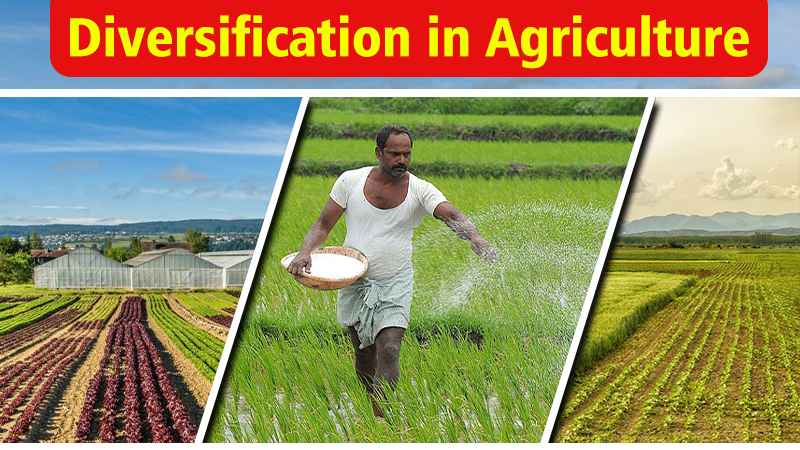India’s about 75% population depends upon agriculture. The agriculture sector has always been a major subject to discuss under its growth and benefits to the farmers from the perspective of the economy.
Since the Golden Revolution period from the year(1991-2003) the era of diversification in agriculture has increased rapidly across the country.
Now, telling in detail about the diversification in agriculture is a vast topic to discuss. Well, before getting deep into the discussion, let us know about the meaning of diversification.
Agriculture diversification refers to the adoption of new or other farm options in the way of animal husbandry, horticulture, poultry farming, etc. The farmers also opt to change the farming /cropping method.
Changing in the cropping method implies diversification between the non-food crops and food, horticulture and conventional crops, low value and high-value crops. The wide scope of the rural sector increases the profitability of the country.
It not only enhances the capital of the income but also brings new opportunities and farmer’s prospective for the rural area. For the productive function of diversification, several machines and implements play a vital role to formulate agricultural activities at a larger scale.
Types Of Agriculture Diversification
Agriculture Diversification is known to be of two types:
Diversification Of Crop Production: Crop Production agriculture diversification states the shifting of a single cropping system to multiple cropping systems. It is also known as Horizontal Diversification.
Diversification Of Productive Activities: When a farmer shifts the agriculture farming sector to another non-farming or another workforce then it is known as diversification of productive activities. Productive diversification is also referred to as Vertical Diversification.
Some of them still undergo the agricultural diversification process, and why it is beneficial to the small and marginal farmers so let’s discuss the reasons for agricultural diversification:
Facilitating alternative Employment Opportunities: It’s not correct saying that half of India’s population does not depend on agriculture. Diversification in agriculture brings job opportunities in fact in the rural sector that help the farmers in the biggest way.
Climate Change: Unfavorable weather conditions can harm the crops but agriculture diversification can control the damage of the crops and prevent major loss.
Profit of Income: Farmers can live a comfortable and happy life once opting for diversification, however, it leads to increasing the farmer’s income.
To give wider choice: It is also a great scope for the farmers to get the wider choice through diversification and builds a new way to live in agriculture.
Kinds Of Productive Diversification
Productive Diversification has immense scope in agriculture for various reasons. So, here are some examples related to productive or horizontal diversification.
Horticulture: India is the best in cultivating different flowers and fruits and also explore to different countries. This not only helps in the workforce but also helps in increasing the economy of the country.
Fisheries: It gives a benefit of marketing of Fisheries products sorting, catching selling and distributing of prawns, crabs, fishes, oysters, etc. There are some states like Andhra Pradesh, Orissa, Tamil Nadu, and Maharashtra that exports fishes to other countries. It however helps in growing Indian GDP to 1.9%.
Livestock: Diversification agriculture is good for commercial purposes. Livestock includes the basic functioning of transporting and carrying agricultural inputs like ploughing. Livestock also includes breeding, nurturing the pastoral animals, raising, etc.
Dairy: During the productive diversification Dairy is one of the important industries for cattle of goats, buffaloes, cows, etc.
Impact Of Agriculture Diversification
Agriculture Diversification is coordinately related to these points:
Reduces Poverty and Increase Livelihood: Diversification almost reduces the poverty of the country and increases the demand for livelihood or commercial purposes.
Sustainable Water Usage: There are some states in India lacking in water especially in the agriculture sector. Through diversification, it improves productivity and management of water.
Employment Security: Agricultural diversification can be more effective when the opportunities are generated for farm commodities to be labor-intensive.
Profitability: The impact of agricultural diversification can be more effective when more opportunities are produced for the farmers and raise the income by exploring new businesses and adopting new techniques and technology.
Conclusion
Agriculture Diversification can be important for the livelihood of the farmers and the growth and GDP of the country. The farmers focused on producing and adopting the new diversification process that helps in increasing the rural sector.
It enhances through an increase in income and is good for soil fertility and pesticide on farms. The farm activities followed in the agriculture sector can be more effective with substantial changes in the economy for structural, legal, productive, social, etc.
Agriculture Diversification helps in earning more profit and increasing the growth of the company.
Agricultural diversification in India demands high-value food products is rapidly increasing than that for staple crops.
The diversification for the different regions can be more effective and creates choices amongst the farmers at a larger scale.
If there are more opportunities for smallholders farmers, then at a larger scale it will be more helpful to grow the economy of the major sector of the country.
In some circumstances, it is proved that the size of the landholdings would be decreased when the land is allocated to fruit and vegetable and cultivation of land in India.
Download KhetiGaadi Mobile Application.
Visit our page for more information about Tractor, Agricultural implements, Tractor Price, Tractor Videos, and Tractor Games.




